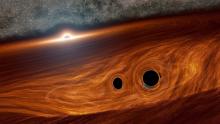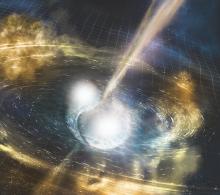Listen to today's episode of StarDate on the web the same day it airs in high-quality streaming audio without any extra ads or announcements. Choose a $8 one-month pass, or listen every day for a year for just $30.
You are here
Cosmic ‘Hum’
The “ticking” of dozens of dead stars has revealed a possible “hum” that fills the universe. Ideas for just what causes the hum range from pairs of supermassive black holes to long “strings” forged in the Big Bang.
The ticking is produced by pulsars — the ultra-dense corpses of once-mighty stars. They spin at up to hundreds of times per second, emitting pulses of radio waves with each turn. They “tick” with a steady beat. Any change in timing is likely caused by something besides the pulsars themselves, such as the gravitational pull of a companion star.
A project known as Nano-grav has monitored several dozen of the steadiest pulsars for years. Tiny changes in their timing have revealed the possible “hum” — perhaps the result of “ripples” in space and time known as gravitational waves.
As they move through space, the waves change the distances between objects by less than the size of an atom. That could cause the pulsar timing to vary by an extremely small amount.
One possible origin for the waves is giant black holes in orbit around each other, churning space like a giant blender.
Another possibility is cosmic strings — vibrating ribbons created in the Big Bang. And yet another is dark matter — matter that we see only through its gravitational pull on the normal matter around it.
Much more work is needed to confirm the Nanograv results — and prove that something is humming along through the universe.
Script by Damond Benningfield






